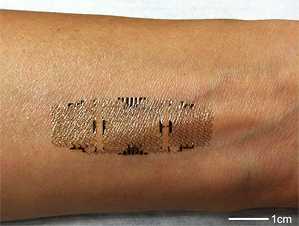Electronic Sensors Printed Directly on the Skin
New electronic tattoos could help monitor health during normal daily activities.
Taking advantage of recent advances in flexible electronics, researchers have devised a way to “print” devices directly onto the skin so people can wear them for an extended period while performing normal daily activities. Such systems could be used to track health and monitor healing near the skin’s surface, as in the case of surgical wounds.

Skin signals: This device, applied directly to the skin, can record useful medical information.
So-called “epidermal electronics” were demonstrated previously in research from the lab of John Rogers, a materials scientist at the University of Illinois at Urbana-Champaign; the devices consist of ultrathin electrodes, electronics, sensors, and wireless power and communication systems. In theory, they could attach to the skin and record and transmit electrophysiological measurements for medical purposes. These early versions of the technology, which were designed to be applied to a thin, soft elastomer backing, were “fine for an office environment,” says Rogers, “but if you wanted to go swimming or take a shower they weren’t able to hold up.” Now, Rogers and his coworkers have figured out how to print the electronics right on the skin, making the device more durable and rugged.
“What we’ve found is that you don’t even need the elastomer backing,” Rogers says. “You can use a rubber stamp to just deliver the ultrathin mesh electronics directly to the surface of the skin.” The researchers also found that they could use commercially available “spray-on bandage” products to add a thin protective layer and bond the system to the skin in a “very robust way,” he says.
Eliminating the elastomer backing makes the device one-thirtieth as thick, and thus “more conformal to the kind of roughness that’s present naturally on the surface of the skin,” says Rogers. It can be worn for up to two weeks before the skin’s natural exfoliation process causes it to flake off.
During the two weeks that it’s attached, the device can measure things like temperature, strain, and the hydration state of the skin, all of which are useful in tracking general health and wellness. One specific application could be to monitor wound healing: if a doctor or nurse attached the system near a surgical wound before the patient left the hospital, it could take measurements and transmit the information wirelessly to the health-care providers.
Rogers says his lab is now focused on developing and refining wireless power sources and communication systems that could be integrated into the system. He says the technology could potentially be commercialized by MC10 (see “Making Stretchable Electronics”), a company he cofounded in 2008. If things go as planned, says Rogers, in about a year and half the company will be developing more sophisticated systems “that really do begin to look like the ones that we’re publishing on now.”
"Destroying the New World Order"
THANK YOU FOR SUPPORTING THE SITE!
Latest Activity
- Top News
- ·
- Everything
All In The Family | Mike Meets Archie For The First Time | The Norman Lear Effect
In the Political Realm They've Gone One Step Too Far!
All In The Family | Mike Meets Archie For The First Time | The Norman Lear Effect
America Copied Germany’s Jerry Can — But Missed The One Genius Detail that Made All the Difference
© 2026 Created by truth.
Powered by
![]()
You need to be a member of 12160 Social Network to add comments!
Join 12160 Social Network